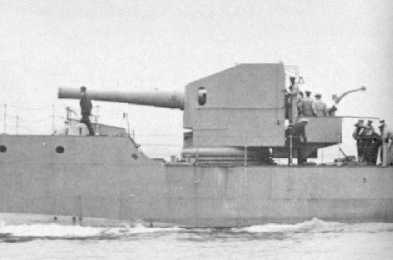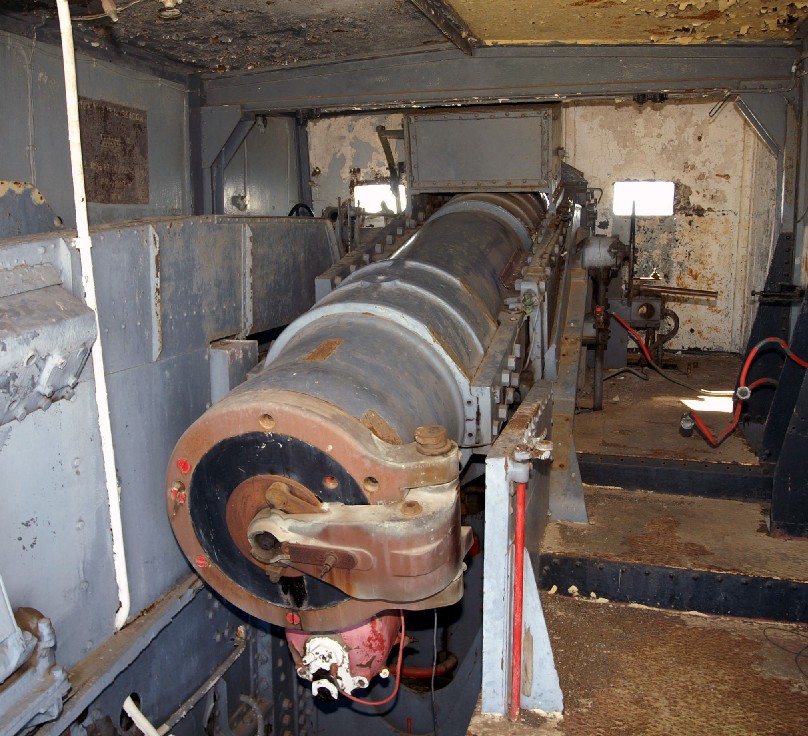

Hooped trunnion guns that differed in some construction details and some external dimensions. Used by both the Army and Navy during the late 1800s. Used both on new construction and to replace old muzzle-loaders on existing ships.
As ships were scrapped in the early 1900s, a total of 27 guns were transferred to the Army between 1904 and 1907, but only four of these were actually used for coastal defense and the rest were scrapped. During World War I many small monitors were to be armed with Mark VI guns removed from old Protected Cruisers of the Edgar class. However, the Army now had a shortage of 9.2" (23.4 cm) guns as a result of the earlier gun scrapping, so some monitors never received 9.2" (23.4 cm) guns and others had theirs removed and received 7.5" (19 cm) guns in their place.
Mark III was constructed of A tube/breech piece taking breech screw, B tube, 5 B hoops to the muzzle/jacket, 1C hoop, trunnion ring, 2C hoop. Bronze sheath over the jacket for balance. Mark IV differed in having a liner for half the length of A tube, no 1C hoop and no bronze sheath. Mark IVA had separate bore and chamber liners. Mark V had a full length liner and alpha tube/A tube/breech piece taking breech screw, B tube, B hoop not to muzzle/jacket, trunnion ring and C hoop. Mark V* designated gun number 44, which had burst at the muzzle in 1897 while on Galatea. It was rebuilt to a partly wire wound design. Mark VI was A tube/breech piece taking breech screw, 1B, 2B tubes to muzzle with 1C and 2C tubes for part length/jacket, trunnion ring and D hoop. Mark VIA had a thicker A tube and shorter 1B tube. Mark VIB had 1B tube replaced by 1B and 2B hoops. 2C tube replaced by C hoop. Mark VIC had 1B tube replaced by 1B and 2B hoops. Breech screw in bush screwed into jacket. Mark VII was A tube/breech piece, B hoop, B tube to muzzle/1C, 2C, 3C/jacket, trunnion ring, D hoop. The breech screw was in a bush screwed into the breech piece and 1C. All of these guns as completed had a three-motion interrupted screw breech. The addition of a * to the Mark number indicated that the front slope of the chamber had been reworked to prevent slip-back at high elevations. Gun number 44, the Mark V*, was also reworked to this standard and then designated as Mark V**. Some coastal defense guns were modified to a continuous motion breech and then given a "B" prefix. C and UC prefixes to early Army guns meant the presence or absence of a hinged carrier for the three-motion breech.
Total number of guns made was 4 Mark III, 28 Mark IV, 18 Mark V, 61 Mark VI and 1 Mark VII.
| Designation | 9.2"/31.5 (23.4 cm) Marks III to VII |
|---|---|
| Ship Class Used On | Mark III: Imperieuse Mark IV: Coast Defense Mark V: Australia, Orlando and Undaunted Mark V and/or Mark VI: Warspite and Aurora Mark VI: Blake and Edgar Mark VII: Shoeburyness Mark VI: Monitors M.19 1 through M.28 2 |
| Date Of Design | about 1880 |
| Date In Service | 1881 |
| Gun Weight | 22 to 24 tons (23 to 25 mt) |
| Gun Length oa | 310 in (7.874 m) |
| Bore Length | about 290 in (7.366 m) |
| Rifling Length | 243.4 in (6.182 m) |
| Grooves | N/A |
| Lands | N/A |
| Twist | N/A |
| Chamber Volume | 4,950 in3 (81.1 dm3) |
| Rate Of Fire | about 1 round per minute 3 |
- ^Steel choke was a problem for these weapons, with M.19 suffering a premature detonation that burst the barrel about 18 inches (45.7 cm) forward of the trunnions.
- ^Monitors M.25, M.26 and M.27 never received their 9.2" (23.4 cm) guns while M.21, M.23 and M.24 had theirs replaced in 1916-17 with 7.5" (19 cm) guns.
- ^The stated ROF for monitors was 0.5 rounds per minute.
| Type | Bag |
|---|---|
| Projectile Types and Weights | APC 2crh: 380 lbs. (172.4 kg) CPC 2crh: 380 lbs. (172.4 kg) |
| Bursting Charge | APC: N/A CPC: 35.4 lbs. (16.1 kg) |
| Projectile Length | APC: N/A CPC: 35.4 in (89.9 cm) |
| Propellant Charge | 163 lbs. (73.9 kg) Pr. Br. 53.5 lbs. (24.3 kg) Cord 30 59.25 lbs. (26.9 kg) MD19 |
| Muzzle Velocity | 2,065 fps (629 mps) Pr. Br. 2,119 fps (646 mps) Cord 30 2,095 fps (639 mps) MD19 |
| Working Pressure | N/A |
| Approximate Barrel Life | N/A |
| Ammunition stowage per gun | Monitors: 120 rounds 1a Others: N/A |
- ^The outfit on Monitors was 60 rounds CP plus 60 rounds HE.
| Elevation | Muzzle Velocity | Distance |
|---|---|---|
| 15 degrees | 2,100 fps (640 mps) | 11,423 yards (10,445 m) |
| 30 degrees | 2,100 fps (640 mps) | 16,664 yards (15,240 m) |
Taken from range tables, but John Campbell calls these figures "optimistic," especially the 30 degree value.
| Designation |
|
|---|---|
| Weight | CPIII: 45 tons (46 mt) Others: N/A |
| Elevation | VCPI: -5 / +15 degrees VCPII: -5 / +12 degrees VCPIII: -5 / +15 degrees Twin Turret: -5 (?) / +10 degrees VCPIII (modified): -5 / +30 degrees |
| Elevation Rate | N/A |
| Train | about +150 / -150 degrees |
| Train Rate | N/A |
| Gun recoil | N/A |
| Loading Angle | N/A |
Data from:
- "Big Gun Monitors: The History of the Design, Construction and Operation of the Royal Navy's Monitors" by Ian Buxton
- "Warship Volume VI" article by John Campbell
- 14 May 2006
- Benchmark
- 05 February 2009
- Updated template to standard, added link, added picture of Gibraltar gun
